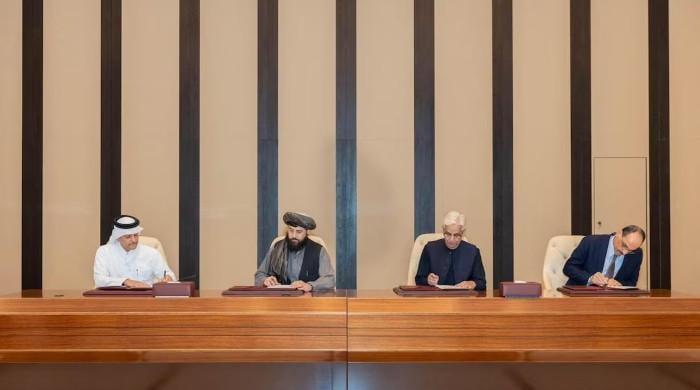At dawn on a crisp October morning, officials in Islamabad and Kabul performed a rare ritual in the history of their troubled border: They agreed to keep talking.
After five days of tense exchanges in Istanbul, with diplomatic strikes, late-night interventions by Turkish and Qatari mediators and negotiators about to board flights home, Pakistan and the Afghan Taliban decided to extend a ceasefire and pledged to work out a mechanism to verify violations.
In most regions, this would be routine diplomacy. In South Asia, where ceasefires are less agreements than quiet moments between artillery fire, it is considered progress. Pakistan’s Defense Minister cautiously called it a “ray of light.”
Taliban officials offered familiar assurances of mutual respect. Türkiye and Qatar congratulated themselves – rightly – on keeping two suspicious neighbors in the same room.
But even the most optimistic diplomats would privately admit to what can be ironically described as a framework for peace, but not yet peace itself. Frames in this relationship are delicate instruments; They rarely survive their first encounter with reality.
To see why even this thin reed is important, you have to understand why the Pakistan-Afghanistan border has rarely been quiet. The 2,640-kilometre Durand Line, drawn in 1893 by a British administrator, was intended as a hard border.
The Afghans never fully accepted it. Pakistan insists it is established international law. Kabul sees an unfinished story. Mutual resentment dates back to the very birth of Pakistan: Afghanistan was the only country to oppose Pakistan’s admission to the United Nations in 1947.
For decades, the dispute over Pashtunistan was simmering. There were border closures, cross-border raids and propaganda campaigns, all fueled by the suspicion that geography had imposed an untrustworthy neighbor.
History offered few remedies. During the Soviet invasion of Afghanistan, Pakistan became the scene of anti-Soviet jihad. More than three million Afghans crossed into Pakistan; we cultivated mujahideen commanders and later the Taliban as instruments of strategic depth.
The deal was simple: Pakistan offered refuge and funding; Afghan militants offered hostility to Moscow and then New Delhi. As is often the case with militant customers, the loyalty proved temporary and the consequences long-lasting.
After 2001, Pakistan officially aligned itself with Washington, while hedging its bets by maintaining relations with Taliban channels it considered safe for the future. The bet, in its cynical way, was rational: foreign armies come and go, but Afghanistan remains eternally at Pakistan’s doorstep.
When the Taliban returned to Kabul in 2021, Pakistani officials anticipated gratitude, influence and perhaps influence. Instead, they discovered an Afghan leadership that recognized past support but rejected present obedience.
The TTP re-emerged, cross-border attacks multiplied and Kabul unexpectedly welcomed India. Islamabad found that its former influence had evaporated, leaving behind only expectations and shame.
In that context, the Istanbul talks mark less a reconciliation than a pause in recriminations. Pakistan came with tough demands: the Taliban must take “clear, verifiable and irreversible measures” against the TTP, declare it a terrorist organization and accept an external mechanism to verify cross-border incidents.
The Afghan delegation resisted, offering instead to detain or expel any TTP agents they encountered, while insisting that Islamabad’s real problem lay within its own territory.
Their response was blunt: they are Pakistanis fighting Pakistan within Pakistan. They are not ours. Thus, both sides repeated the circular logic that has long thwarted counterterrorism in the region. The fact that the parties reached even a modest agreement was largely due to external mediation. Türkiye and Qatar deployed diplomatic force that few countries possess in Kabul and Islamabad simultaneously.
Both sides were firmly reminded that escalation was costly and isolation worse. Border clashes had killed fighters on both sides. Commercial crossings were briefly closed.
Neither government is in the mood for uncontrolled escalation; Both fear losing control of events along a border where tribes, smugglers and militants sometimes move faster than states. However, mistrust remains thick enough to carve.
Pakistan is convinced that the Afghan Taliban is offering shelter, ideological sympathy and, at times, logistical leniency to the TTP. Afghan leaders believe Pakistan has not abandoned the temptation to intrude across the Durand Line, whether through intelligence networks, airstrikes or pressure on border communities.
Each side sees the other as the author of their insecurity. They are both partly right. And each suspects that the other is courting India, the United States or China at their expense, depending on the week. For Pakistan, the stakes are immediate. Since the return of the Taliban to Kabul, the TTP has launched attacks on Pakistani soil with renewed vigor.
Islamabad faces a stubborn insurgency in Khyber Pakhtunkhwa and Balochistan, fragile economic conditions and political volatility. Our military, already overburdened by internal security commitments and eastern vigilance against India, has little patience left for another open front. Chinese pressure adds urgency: Beijing wants CPEC routes to be safe and has little tolerance for militant adventurism near its investments.
For Afghanistan, the calculation is no less clear. The Taliban government needs trade routes, fuel, food imports and diplomatic recognition. Pakistan remains Afghanistan’s main commercial artery to the world. Alienating Islamabad while dealing with Western sanctions, internal economic collapse and restless commanders is unsustainable.
Kabul knows that too much belligerence risks provoking a neighbor with stronger conventional forces and a demonstrated willingness to attack across borders.
The truce, therefore, is less an embrace than a grudging recognition that neither side can afford a breakup. But experience urges sobriety. We have been down this road before: negotiating with militants in Swat in 2008, in South Waziristan in 2009 and again in 2014, each time discovering that truces with ideologues turn into traps.
Diplomacy with the Afghan Taliban has also oscillated between high expectations and rude awakenings. In 2021, our officials were photographed drinking tea in Kabul days after the Taliban takeover; two years later, they found themselves threatening air strikes against their former protégés.
The challenge now is to transform a tenuous ceasefire into something more lasting, linked not to feelings but to structures. For the new monitoring mechanism to have any meaning, it must ultimately include transparent reporting, independent verification, and consequences for violations.
Economic incentives (access to transit, energy cooperation, trade facilitation) will be essential incentives. So will multilateral pressure: China, Iran, Russia and the Gulf states have interests in a stable border and each has some influence over Kabul. No one wants Afghanistan to once again become a sanctuary for transnational militants.
The burden also falls on the Afghan Taliban. To treat sovereignty as more than a slogan, they must confront the central paradox of their rule: a government cannot host armed groups that attack its neighbors and still expect recognition, legitimacy or investment. Many states – from Egypt to Saudi Arabia to Indonesia – have discovered that ideological kinship dies where national survival begins. Kabul may yet learn the same lesson, although at a cost that remains uncertain.
In truth, the Istanbul agreement is less a victory than a respite. Its success will depend less on what was signed in Türkiye than on what is implemented in the rocky hills of Kurram and Kandahar. If the militants cross the line again, or if Pakistan strikes unilaterally, the current document will become another entry in a long archive of failed understandings.
However, if the calm endures, however uncomfortable, it will mark a rare moment when South Asian history stops rather than repeats itself. For now, the guns have fallen silent, the diplomats have exhaled, and the border has been granted a brief interlude.
In a region where geography rarely forgives strategic miscalculations, even fragile pauses have value. Peace is a distant ambition; survival, for the moment, is achievement enough.
The writer has a PhD from the University of Birmingham, UK. He tweets/posts @NaazirMahmood and can be reached at: [email protected]
Disclaimer: The views expressed in this article are those of the writer and do not necessarily reflect the editorial policy of PakGazette.tv.
Originally published in The News




